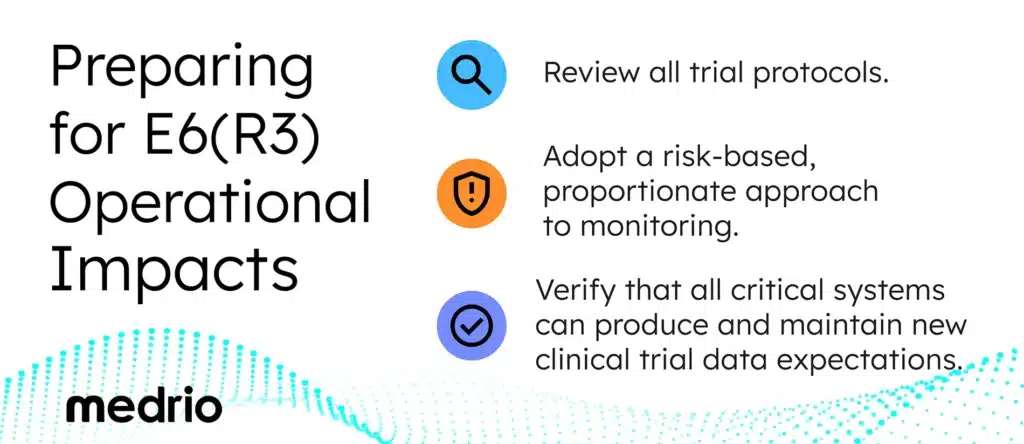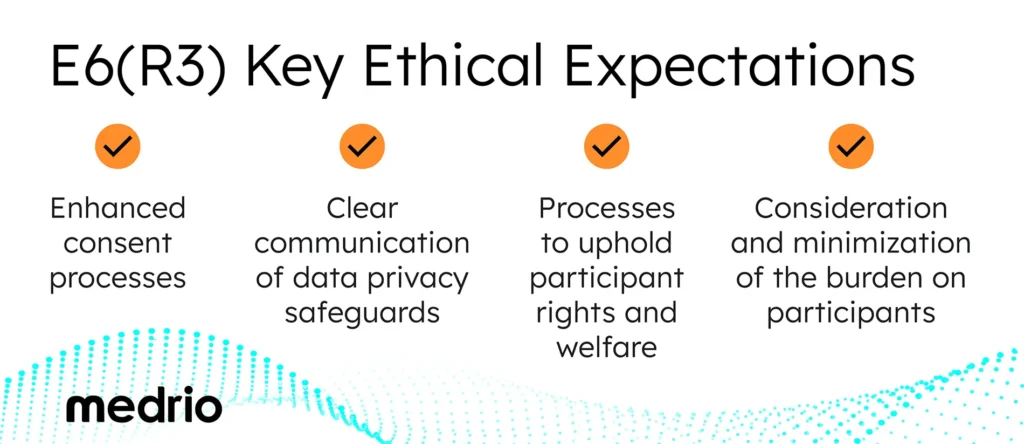Contributing experts at Medrio: Ian Davison, Subject Matter Expert (Based in UK) and Cameron Kinnear, Principle Solutions Consultant EMEA
Clinical research in Europe is approaching a key regulatory milestone. The ICH E6(R3) Guideline for Good Clinical Practice (GCP) takes effect in the EU in July 2025.
This updated guidance reshapes expectations around data integrity, technology use, decentralized trials, and risk-based quality management.
In this article, you’ll find out:
- What is E6(R3)?
- What is the timeline for E6(R3)?
- What are the key changes in E6(R3)?
- What are the operational impacts?
- What are the ethical considerations?
- How can you choose the right technology to support E6(R3)?
- Frequently asked questions about E6(R3)
What is ICH E6(R3)?
ICH E6(R3) is the latest version of guidance to harmonize standards for the design, conduct, recording, and reporting of clinical trials globally.
E6 was first issued in 1996 by the International Council for Harmonization (ICH). In 2016, E6(R2) incorporated quality risk management and technology considerations. In 2025, E6(R3) was finalized and goes even further.
E6(R3) modernizes GCP by:
- Introducing a ‘Quality by Design’ approach
- Clarifying data governance
- Supporting participant-centric design
- Encouraging technology-agnostic approaches
- Clarifying roles and responsibilities
The latest guidance maintains the core principles of patient safety, rights, and data integrity.
What is the timeline for E6(R3)?
ICH published the Good Clinical Practice (GCP) guideline E6(R3) Principles and Annex 1 on January 6, 2025. Timelines for implementation of the guidance are set by the regional regulatory authority.
- January 6, 2025: GCP E6(R3) Principles and Annex 1 published.
- July 23, 2025: The European Medicines Agency (EMA) implementation date.
- No date defined: The U.S. Food and Drug Administration (FDA) has not yet set a date.
- May 2023: While ICH E6(R3) was still in the development phase, the FDA released a draft guidance in May 2023.
- No date defined: Other ICH member nations and regions are still in the process of adopting E6(R3).

Once adopted, compliance will be mandatory for all sponsors and CROs conducting clinical trials in the EU. For many organizations, this update means updating SOPs, validation strategies, and oversight processes.
Key Changes in E6(R3)
R3 moves away from a prescriptive model to a flexible, risk-based approach. It integrates modern trial methods and technologies to create a framework for efficient research.
E6(R3) introduces:
- Risk-based, proportionate approaches to trial conduct and oversight
- Greater emphasis on robust science and study design
- Flexibility for new technologies and decentralized models
The new guidance emphasizes quality, risk management, and technology in several ways.
- Pro-active risk management: A focus on identifying critical-to-quality issues and mitigating risks
- Documentation: Sponsors must document how quality is built into processes and how risks to trial integrity are mitigated.
- Data governance: There are clarified expectations for metadata, audit trails, and traceability.
- Technology neutrality: Any system can be used if validation and oversight are demonstrated.
Operational Impacts
The upcoming ICH E6(R3) guidelines will significantly impact how clinical trials are planned, executed, and documented across Europe. Sponsors and CROs must adapt their operational practices to maintain compliance and inspection readiness.
To remain compliant and leverage new approaches, stakeholders should review trial protocols, monitoring strategies, and data management systems.

Trial protocols
Sponsors should review all trial protocols to ensure they align with the new expectations under E6(R3).
The guideline emphasizes robust scientific rationale, patient-centricity, clear risk assessments, and proportionate quality management plans.
Review protocols to identify:
- Opportunities for decentralized activities
- New technology use possibilities
- Gaps in study design
- Issues with consent processes
- Potential problems with data management
Early review and updates will reduce delays, support inspection readiness, and protect participant safety.
Monitoring Strategies
E6(R3) requires sponsors to adopt a risk-based, proportionate approach to monitoring rather than relying solely on routine site visits.
This new approach means tailoring oversight to specific risks, technologies, and trial designs. Sponsors should re-evaluate monitoring strategies now to avoid compliance gaps later.
Review your monitoring approach for:
- Monitoring activities proportionate to the study risk level and complexity
- Remote monitoring tools that can identify emerging issues quickly
- Data analytics and reporting support for real-time decision-making
- Clear oversight of remote activities and vendors in decentralized trials
By taking time to adjust your monitoring strategy now, your trials can remain compliant and inspection-ready. A proactive approach also protects patient safety and strengthens data integrity.
Documentation and Data Management Updates
E6(R3) introduces more precise expectations for clinical trial data capture, management, and retention. Additionally, the essential documents definition is expanded to include comprehensive metadata and tamper-evident audit trails.
This shift means organizations must verify that all critical systems can produce and maintain these records throughout the trial lifecycle.
Ensure your study is compliant with:
- Tamper-evident audit trails
- Metadata for source data and derived data
- Accessible documentation for inspection at any time
- Clear mapping of metadata and audit trails
Ethical Considerations
E6(R3) reinforces that protecting participants is at the core of every clinical trial. This priority is especially true as studies become more decentralized and technology-driven.
The guideline elevates expectations around informed consent, transparency, and privacy. It requires organizations to adopt consistent practices that respect participant rights across all trial models.

Key expectations under E6(R3) include:
- Enhanced consent processes
- Clear communication of data privacy safeguards
- Processes to uphold participant rights and welfare
- Consideration and minimization of the burden on participants
These measures aim to build trust as trial designs evolve and technology becomes an even bigger part of trials.
The Right Technology to Support E6(R3)
E6(R3) raises the bar for data integrity, validation, and patient-centric technology. Your selected CDMS/EDC will directly impact your ability to remain compliant and inspection-ready under this new guidance.
When evaluating CDMS/EDC partners, consider if they offer:
- Documented validation, robust audit trails, and comprehensive data security controls
- Remote monitoring, eConsent integrations, and support for decentralized trials
- Configurable risk-based monitoring tools
- Transparent data governance features, including real-time reporting and role-based permissions
At Medrio, our solutions align with the latest regulatory requirements and emerging technology trends. Our SMEs understand the European regulatory landscape and the operational realities of running global studies.
If you’d like to explore how Medrio can help your team build studies compliant with E6(R3), get in touch today.
Frequently Asked Questions about ICH E6
Common questions about E6(R3).
What is the difference between ICH E6(R2) and E6(R3)?
ICH E6(R3) expands risk-based quality management, clarifies data integrity expectations, supports decentralized trials, and introduces technology-neutral principles. Compared to E6(R2), it is more flexible but more explicit in documentation and governance requirements.
Is ICH E6 mandatory in the US?
While the FDA endorses ICH E6 principles, adoption and enforcement timelines may differ. Sponsors conducting global trials should plan for compliance wherever trials are conducted, including in Europe, where it will be mandatory.
What is the main focus of data governance in ICH GCP E6(R3)?
The main focus of data governance in ICH GCP E6(R3) includes ensuring data is attributable, legible, contemporaneous, original, and accurate (ALCOA). It also provides guidance on supporting data with validated systems and audit trails. Finally, it offers guidance on protecting data through proportionate risk-based oversight and documented controls.
The blog does not constitute legal or other professional guidance. Please refer to proper industry documentation or known notified bodies for legal or professional advice.



